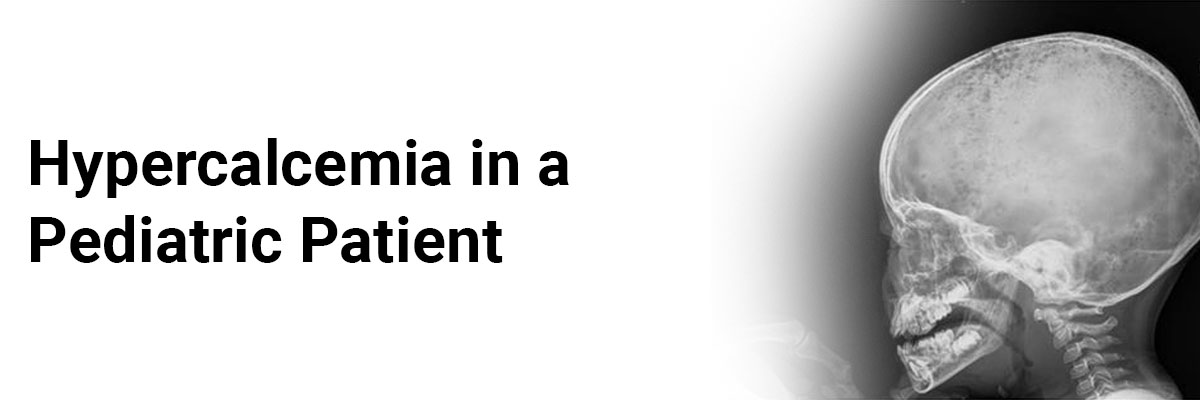
 IJCP Editorial Team
IJCP Editorial Team
Hypercalcemia in a pediatric patient
We present the case of a 7-month-old infant. She has two-month history of worsening intermittent vomiting and failure to thrive despite nutritional optimization and trial of different infant formulas. Past medical history revealed prolonged NICU stay principally due to delays in oral feeding. She carried no pulmonary, cardiac, or intestinal complications of prematurity.
On presentation, she did not have acute distress, and maintained normal vital signs. Weight and height were both found below the first percentile. Physical examination revealed the presence of hepatosplenomegaly. Laboratory workup showed elevated transaminases and significant hypercalcemia (4.47 mmol/L; Normal Range: 2.12-2.74mmol/L). Baseline phosphorus level was normal and the parathyroid hormone level was appropriately suppressed. She was hospitalized for management and further workup.
Aggressive intravascular fluid resuscitation with normal saline only partly improved serum calcium levels. Furosemide and calcitonin were given in succession, but they did not show a noticeable impact on serum calcium levels. Two doses of pamidronate, 0.5 mg/kg each two days apart, were ultimately successful in restoring normal calcium levels. She was then also switched to low calcium infant formula, Calcilo- XD.
An extensive workup for viral and fungal etiologies came out to be negative, along with the evaluation for metabolic, genetic, and oncologic causes of hypercalcemia. The skeletal survey did not reveal any lytic lesions; CT scan of the chest, abdomen, and pelvis came out to be negative for the presence of lymphadenopathy or pulmonary lesions. Hepatosplenomegaly was confirmed with a CT scan; however, the underlying pathology was not revealed until a liver biopsy was conducted for persistently raised liver enzymes and massive hepatomegaly. Liver biopsy revealed lobular histiocytic infiltrate with well-formed granulomas, hemophagocytosis, and raised portal/periportal and pericellular fibrosis with bridging showing chronicity, with no further evidence showing an underlying etiology of the granulomas.
After 3 weeks of hospitalization, she was discharged home following adequate weight gain and achievement of normal and stable calcium levels. Liver enzymes improved but remained elevated.
She again required readmission after one month for the recurrence of vomiting and poor weight. No fevers were reported. Workup on this admission revealed leukopenia and return of hypercalcemia. Chronic granulomatous disease, immunodeficiency, tuberculosis, and hemophagocytic lymphohistiocytosis (HLH) were considered the differential diagnosis; but screening was negative. HLH genotyping revealed only a single allele mutation on the UNC13 gene, but this variant did not justify her findings. Despite the absence of a standard definition of infantile sarcoidosis, this disease was believed due to elevated levels of angiotensin-converting enzyme (ACE) at 108 U/L (18-90). Due to the negative results for a possible underlying immunodeficiency and malignancy, she was prescribed prednisolone 1 mg/kg/day for hypercalcemia. She stayed afebrile and was discharged home in stable condition with prednisolone.
Following 5 weeks of prednisolone treatment, she presented with daily emesis and low-grade fevers. Complete blood count revealed pancytopenia and peripheral smear displayed fungal elements. She was then immediately admitted to the intensive care unit for disseminated fungal infection. Urine Histoplasma antigen came out to be positive. Systemic antifungal treatment was started. Interestingly, serum calcium and liver enzyme levels were normal during the third admission. Due to disseminated fungal infection, prednisolone was discontinued and a hydrocortisone taper was initiated. She showed an excellent response to antifungal treatment. Hepatosplenomegaly resolved and all other serum markers improved gradually. She continued the systemic antifungal treatment for 9 months and made a full recovery as well as caught up with normal growth and development.
Source: Sonawalla A, Tas V, Raisingani M, Tas E. A Rare and Potentially Fatal Etiology of Hypercalcemia in an Infant. Case Reports in Endocrinology. 2019; 2019. https://doi.org/10.1155/2019/4270852

IJCP Editorial Team
Comprising seasoned professionals and experts from the medical field, the IJCP editorial team is dedicated to delivering timely and accurate content and thriving to provide attention-grabbing information for the readers. What sets them apart are their diverse expertise, spanning academia, research, and clinical practice, and their dedication to upholding the highest standards of quality and integrity. With a wealth of experience and a commitment to excellence, the IJCP editorial team strives to provide valuable perspectives, the latest trends, and in-depth analyses across various medical domains, all in a way that keeps you interested and engaged.




















Please login to comment on this article